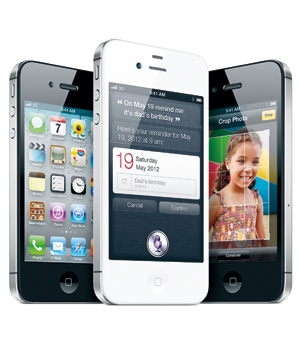Happy birthday, iPhone

Courtesy of Apple Inc.
January 30, 2012
Freshman Luke Baird is at the Rec Center on a stationary bike watching an episode of “Family Guy” on his iPhone. He pauses the show to check an email, respond to a text and then opens an application that tracks fitness progression while he continues to pedal.
To most students with iPhones, this is nothing new.
This month marks the five-year anniversary of the original Apple Inc. iPhone. On its first release, only 4 GB and 8 GB models were available and there was no Mac App Store.
Today, the device is available in a 64 GB model and with over 500 thousand apps. Users now have the ability to game, study, research and communicate with the swipe of a finger.
“Last week a friend and I were arguing about the director of a movie and I whipped out my iPhone, opened the IMDB app and found the answer in less than a minute,” Baird said. “It never would have been that easy five years ago.”
Now with Apple Inc.’s iCloud, iPhone users can push all of their content wirelessly to other supported devices.
“I love the Cloud. If I forget to bring my computer to class, I can still take notes on my phone and sync them to my computer so I can read them on a bigger screen,” Baird said. “I feel like with my phone I will never miss a beat.”
To Murali Shanker, professor of management & information systems as Kent State, the user-friendly nature of the iPhone and, likewise, all of Apple Inc.’s products is “remarkable.”
“Apple has really been good in the last five to seven years of defining products that create a whole new segment,” Shanker said.
Not only did Apple Inc. create a whole new market and way of life with the Mac App Store, its touch-screen technology has become the gold standard for smartphones.
The original iPhone debuted the use of a multi-touch interface which is now common for every touch-screen smartphone and tablet on today’s market.
“The whole idea of a smartphone is based off the iPhone. They changed phones completely,” Shanker said. “Windows and Android are trying to follow, but Apple is really good at what it does.”
As of December, the numbers support Shanker’s statement. According to Canaccord Genuity Inc., a financial research firm, the iPhone owns 52 percent of the smartphone industry’s overall profits. Samsung owns a distant second with 29 percent.
This contradicts speculation that the company would lose momentum following Chairman and CEO Steve Jobs’ death in October of last year. Jobs was the brain behind the original iPhone, and co-founder of Apple Inc., but unfortunately, he passed away immediately preceding the release of the newest model, the iPhone 4S, which sold 4 million units in its first weekend.
iPhone timeline
June 2007
The first iPhone is available in the United States. The 4 GB model costs $500 and the 8 GB costs $600. Three months later Apple Inc. drops the price for both models by $100.
March 2008
Apple Inc. releases the beta for iOS software which allows people to create apps.
July 2008
Apple Inc. releases the iPhone 3G available in 8 GB and 16 GB models. The phone boasts GPS capability and faster 3G connectivity. At this point, there are about 500 available apps for the iPhone.
April 2009
There are over 35,000 apps in the app store with over 1 million total downloads.
June 2009
Apple Inc. releases the iPhone 3GS which sports an A8 processor making it twice as fast as the iPhone 3G across the board. The phone is available in 8, 16 and 32 GB models. The phone introduces Nike+ technology, voice control, 256 MB of ram and a 3.0 megapixel camera.
April 2010
Apple Inc. releases iOS 4 for its handheld devices which introduces multitasking gestures, Bluetooth support, iBooks, and updated programs for e-mail, photography and video editing.
June 2010
Apple Inc. releases the iPhone 4; it’s fastest phone yet. The phone features a faster processor, Retina display, longer battery life, a front-ward facing camera and an internal antenna. It also has a 5 megapixel camera capable of filming in 720p HD.
October 2011
Apple Inc. releases the iPhone 4S along with its new operating system iOS 5. The phone boasts faster speeds than the iPhone 4 along with the voice command system Siri. With iOS 5, users can take advantage of the iCloud and push information seamlessly between all Apple Inc. devices.
Contact Matt North at [email protected].











